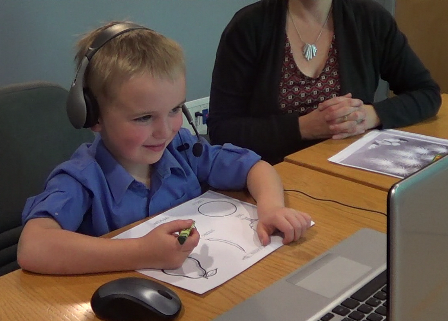Guest Blogger: Wendy, OTR/L

As an Occupational Therapist who has worked in different school environments for 20(+) years, I often get the question: How do you provide Occupational Therapy services online? When I first began providing online OT, I had some skepticism too. The fact is, just like services provided with face to face interaction we are all working toward meeting the student’s IEP goals and collaborating with the IEP team to help the student reach his maximum functional potential; to influence a better life for our students.
As OT’s we all have our “bag of tricks.” We work on fine motor skills, visual motor skills, sensory regulation, activities of daily living. But how exactly can you work on those skills with the OT in California and the student in Wisconsin? First, for this generation of kids, being on the computer is second nature. And yet meeting with the OT online is a novelty for the kids. Off the bat, they think it is fun. We connect. We talk about how life is different in California compared to Wisconsin. That connection no matter in person or online is everything. I believe for kids and adults, getting buy in and understanding why we are working on our goals is critical. I often confer with the student and let him know what his IEP goals are and why these goals are important for his school success.
If we are working on handwriting, I regularly use assignments the student is working on in class. To develop foundational skills for handwriting, perhaps the student uses theraputty for fine motor coordination and strengthening, perhaps the student performs core exercises so that he can sit for longer periods of time for writing assignments, perhaps I make the recommendation for various adaptations (pencil grips, wider pencils, working at a vertical surface), perhaps we develop regulatory strategies to help her achieve the just right level of alertness to attend to and complete classroom assignments.
The key to success for the student is carry-over of learned skills in our Occupational Therapy sessions to the classroom. We do not work in a vacuum. We collaborate with classroom teachers, special education teachers, parents, administrators, other related services, and the e-helper in our sessions. The e-helper is an integral part of our team. He or she observes our “bag of tricks” in our sessions and we can confer how the student can take these learned skills and adaptations into the classroom. At the next session, we talk about what is working and what may not be working in the classroom. This communication in and out of our sessions is vital for the student’s success: we email, we talk on the phone, we use our virtual backpack for homework activities.
So how do we provide Occupational Therapy online? We connect, we collaborate, we see the light that shines in each of our students. We embody the TinyEYE spirit: It is our privilege to serve and we influence a better life for our students.



